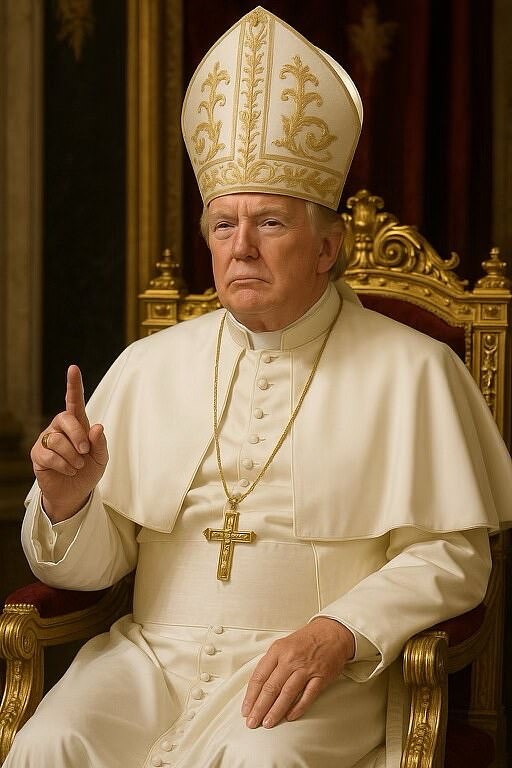The Controversial Truth Social Post
In yet another headline-grabbing move, U.S. President Donald Trump has found himself at the center of a global firestorm after posting an AI-generated image of himself dressed as the Pope on his social media platform, Truth Social. The digitally-altered image shows Trump in full papal regalia—complete with a white miter, ornate robe, and a large crucifix—posing as the spiritual leader of the Catholic Church.
While Trump is no stranger to provocative visuals and over-the-top memes, this particular post came at a deeply sensitive time—just one week after the funeral of Pope Francis, who passed away on Easter Monday at the age of 88. The timing of the post immediately raised eyebrows and drew criticism from all sides, including religious leaders, Catholic followers, and political opponents.
The post wasn’t an isolated event. It followed remarks Trump made jokingly to reporters about becoming the next Pope. “I’d like to be Pope. That would be my number one choice,” he quipped on the White House lawn, adding that he didn’t have a specific preference for the next pontiff, though he noted a “very good” cardinal in New York—seemingly a nod to Cardinal Timothy Dolan.
Whether Trump intended the image to be satire, a jab at the Church, or another act of self-promotion, the backlash was swift and severe.
Timing Raises Eyebrows Among Catholics Worldwide
The image struck a nerve largely due to its proximity to Pope Francis’ passing. Just seven days earlier, the Catholic world gathered in Vatican City to say goodbye to the beloved pontiff. St. Peter’s Basilica was filled with mourners, cardinals, and heads of state. Pope Francis, known for his humility and social justice advocacy, had served the Church for more than a decade.
The funeral marked a period of deep mourning and spiritual reflection for Catholics around the globe. For many, seeing a figure like Donald Trump insert himself into this sacred moment—via artificial imagery, no less—was viewed as not just distasteful, but outright blasphemous.
Catholic communities online and in religious forums expressed a range of reactions: disbelief, sorrow, anger, and disappointment. “This is not the time for jokes or ego-stroking,” one Catholic blogger wrote. “A man who has never claimed deep faith suddenly posing as the Pope—on the week the world is mourning a holy man—is profoundly tone-deaf.”
The Backlash: Public and Religious Figures Respond
Accusations of Disrespect and Religious Mockery
Criticism came in quickly, and from many quarters. Religious scholars, political commentators, and average citizens alike condemned the post as disrespectful, inappropriate, and offensive.
“This is a desecration of a sacred image,” said one Catholic priest in New York during a televised interview. “Even if it’s AI, even if it’s meant in jest, it trivializes the role of the Pope and the emotional weight of this moment.”
Another faith leader tweeted, “Mocking the papacy for attention or laughs, especially as Catholics grieve, is not humor—it’s cruelty disguised as a meme.”
Others questioned the spiritual implications. “This isn’t just political satire—it’s religious mockery,” wrote a columnist for a Christian news site. “It plays into a dangerous narrative that faith and leadership can be meme-ified with no consequences.”
Social Media Reacts with Fury and Disgust
Unsurprisingly, the internet exploded. Hashtags like #NotMyPope and #DisrespectfulTrump began trending, as users from all over the world expressed their disbelief.
Twitter and Threads were filled with messages condemning the post:
- “Trump is literally mocking the Christian world with this image.”
- “This is disgusting. A sacred tradition turned into a Trump meme.”
- “The audacity… Catholics are grieving and THIS is what he posts?”
Even some of Trump’s usual defenders expressed concern. “I support Trump but this was unnecessary and offensive,” one user commented on Truth Social. “It’s OK to make memes, but not when people are mourning a spiritual leader.”
The White House, which also shared the image on its official X account, drew even more heat. Critics demanded an apology, questioning whether government officials were complicit in the disrespect. Others warned about the ethical line crossed by promoting AI-generated content that mocks religious institutions.
Trump’s History with AI-Generated Images
Previous Deepfakes and Digital Alterations
This isn’t Donald Trump’s first foray into AI-generated visuals. Over the past two years, he has increasingly shared digitally manipulated images portraying himself as everything from a superhero to a historical icon.
In January, Trump posted an AI image of himself in prayer, flanked by angels and American flags. A month later, another deepfake depicted him saving a crowd from a burning building—a clear nod to messianic symbolism.
Critics argue that these posts are part of a larger strategy to build a mythic persona that resonates with his base. By leaning into hyperbole and spectacle, Trump maintains media relevance and creates an alternate digital reality where he is seen as a savior figure.
Using AI for Political Image-Building
Experts warn that this trend isn’t just about internet humor—it’s a calculated political move. Trump’s use of AI-generated images taps into powerful visual storytelling that reinforces his brand as a larger-than-life figure.
“Trump understands the power of imagery,” said a political analyst. “He’s using AI as a propaganda tool to blur the line between reality and myth. It’s effective, it’s dangerous, and it’s increasingly hard to counter.”
However, the pope image has crossed a line for many. Unlike superhero memes or war-hero renditions, this image touches on sacred religious symbolism and has alienated a key segment of the population: faith-driven voters.



